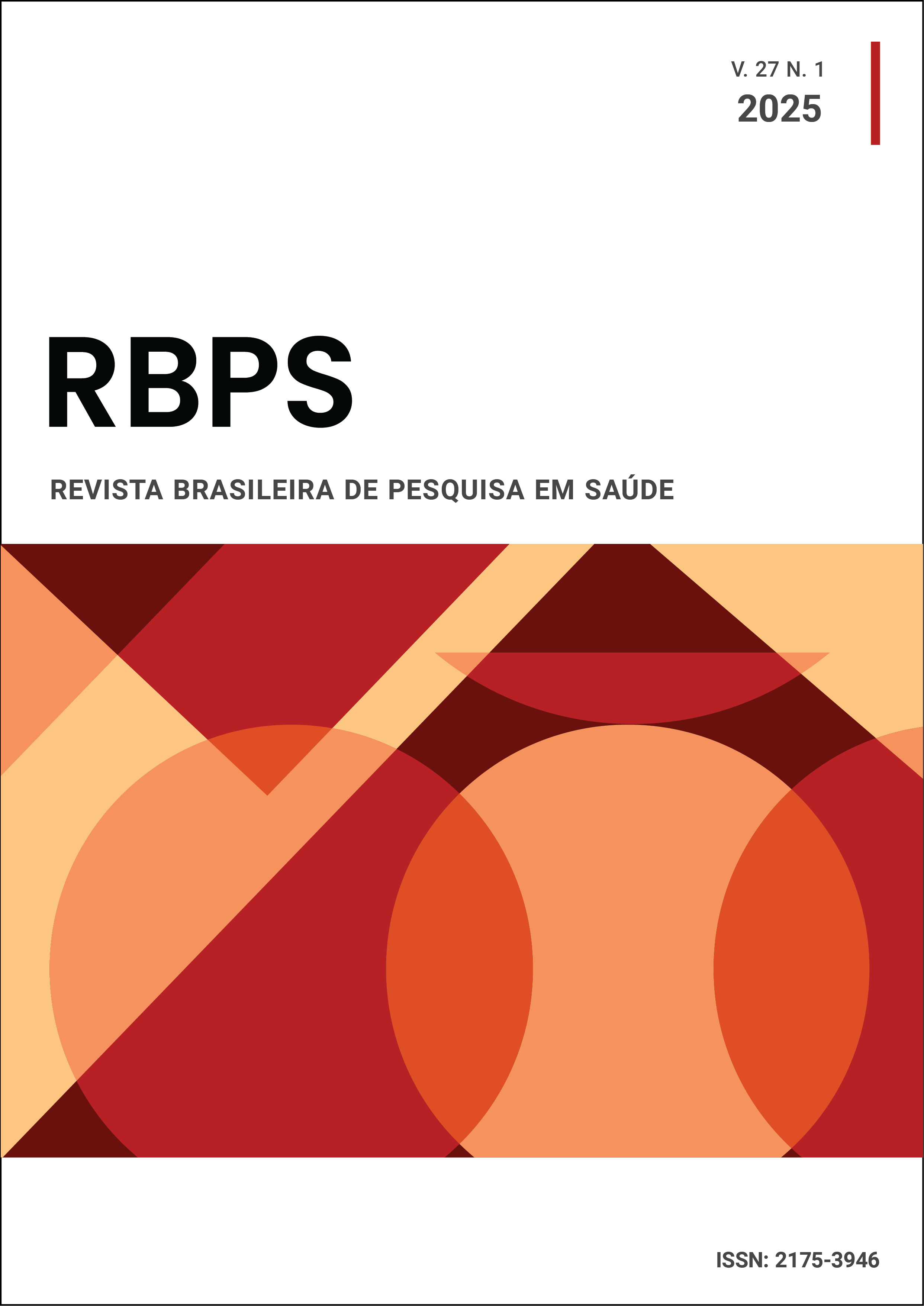Saúde mental de estudantes universitários após retorno ao ensino presencial
um estudo transversal
DOI:
https://doi.org/10.47456/rbps.v27i1.42965Palavras-chave:
Transtornos mentais, Estudantes universitários, Saúde mentalResumo
Introdução: A pandemia da COVID-19 teve impacto significativo na saúde mental de indivíduos em todo o mundo, especialmente entre estudantes universitários. Objetivo: Avaliar a saúde mental de estudantes universitários após o retorno ao ensino presencial no contexto pós-pandemia de COVID-19. Métodos: Estudo transversal, do tipo survey, realizado entre julho e agosto de 2022, com estudantes da Universidade Federal do Espírito Santo. A coleta de dados foi realizada por meio de questionário online, enviado ao e-mail institucional de todos os estudantes. A avaliação dos sintomas de ansiedade e depressão foi feita com as escalas Generalized Anxiety Disorder-7 (GAD-7) e Patient Health Questionnaire-9 (PHQ-9). Utilizou-se regressão logística binária, tendo como variáveis dependentes os sintomas de ansiedade e depressão. Resultados: Participaram do estudo 1.103 estudantes. As escalas indicaram que 56,7% (n=625) apresentaram escores compatíveis com transtornos de ansiedade e depressão simultaneamente. Pensamentos relacionados à automutilação ou suicídio foram relatados por 422 (38,3%) participantes. A regressão logística binária revelou pouca ou nenhuma associação entre as variáveis independentes analisadas e os desfechos de saúde mental. Conclusão: O retorno ao ensino presencial tem exposto um número significativo de estudantes com transtornos mentais não diagnosticados e não tratados, o que demanda atenção e ações institucionais específicas.
Downloads
Referências
Auerbach RP, Alonso J, Axinn WG, Cuijpers P, Ebert DD, Green JG, et al. Mental disorders among college students in the World Health Organization World Mental Health Surveys. Psychol Med. 2016;46(14):2955–70. doi: 10.1017/S0033291716001665.
Li W, Zhao Z, Chen D, Cao Y, Yang G, Zhang T, et al. Prevalence and associated factors of depression and anxiety symptoms among college students: a systematic review and meta-analysis. J Child Psychol Psychiatry. 2022;63(4):411–28. doi: 10.1111/jcpp.13606.
Li Y, Wang A, Wu Y, Han N, Huang H. Impact of the COVID-19 pandemic on the mental health of college students: a systematic review and meta-analysis. Front Psychol. 2021;12:669119. doi: 10.3389/fpsyg.2021.669119.
Almeida PR, Jung HS, Silva LQ. Retorno às aulas: entre o ensino presencial e o ensino a distância, novas tendências. Rev Prâksis. 2021;3:e2556. doi: 10.25112/rpr.v3.2556.
Azzi DV, Melo J, Neto AAC, Dutra JB, Sato TO, Carvalho RA, et al. Quality of life, physical activity and burnout syndrome during online learning period in Brazilian university students during the COVID-19 pandemic: a cluster analysis. Psychol Health Med. 2022;27(4):466–78. doi: 10.1080/13548506.2021.1944656.
Lopes AR, Nihei OK. Depression, anxiety and stress symptoms in Brazilian university students during the COVID-19 pandemic: predictors and association with life satisfaction, psychological well-being and coping strategies. PLoS One. 2021;16(10):e0258493. doi: 10.1371/journal.pone.0258493.
Maia BR, Dias PC. Anxiety, depression and stress in university students: the impact of COVID-19. Estud Psicol (Campinas). 2020;37:e200067. doi: 10.1590/1982-0275202037e200067.
Wagner F, Wagner R, Kolanisi U, Mtetwa S, Mokoena M. The relationship between depression symptoms and academic performance among first-year undergraduate students at a South African university: a cross-sectional study. BMC Public Health. 2022;22:1–9.
Lun KWC, Chan CK, Ip PKY, Ma SY, Tsai WWY, Wong CSY, et al. Depression and anxiety among university students in Hong Kong. Hong Kong Med J. 2018;24(5):466–72.
Flesch BD, Houvèssou GM, Munhoz TN, Silva RA, Santos IS. Episódio depressivo maior entre universitários do sul do Brasil. Rev Saude Publica. 2020;54:11.
Sharma A, Minh Duc NT, Luu Lam Thang T, Nam NH, Ng SJ, Abbas KS, et al. A consensus-based checklist for reporting of survey studies (CROSS). J Gen Intern Med. 2021;36(10):3179–87.
Spitzer RL, Kroenke K, Williams JBW, Löwe B. A brief measure for assessing generalized anxiety disorder: the GAD-7. Arch Intern Med. 2006;166(10):1092–7. doi: 10.1001/archinte.166.10.1092.
Levis B, Benedetti A, Thombs BD. Accuracy of Patient Health Questionnaire-9 (PHQ-9) for screening to detect major depression: individual participant data meta-analysis. BMJ. 2019;365:l1476. doi: 10.1136/bmj.l1476.
Plummer F, Manea L, Trepel D, McMillan D. Screening for anxiety disorders with the GAD-7 and GAD-2: a systematic review and diagnostic metaanalysis. Gen Hosp Psychiatry. 2016;39:24–31. doi: 10.1016/j.genhosppsych.2015.11.005.
Kroenke K, Spitzer RL, Williams JBW. The PHQ-9: validity of a brief depression severity measure. J Gen Intern Med. 2001;16(9):606–13. doi: 10.1046/j.1525-1497.2001.016009606.x.
Kroenke K, Spitzer RL, Williams JBW, Monahan PO, Löwe B. Anxiety disorders in primary care: prevalence, impairment, comorbidity, and detection. Ann Intern Med. 2007;146(5):317–25. doi: 10.7326/0003-4819-146-5-200703060-00004.
Gaiotto EMG, Trapé CA, Campos CMS, et al. Resposta a necessidades em saúde mental de estudantes universitários: uma revisão rápida. Rev Saude Publica. 2021;55:75. doi: 10.11606/s1518-8787.2021055003363.
Fernandez A, Howse E, Rubio-Valera M, Thornicroft G. Setting-based interventions to promote mental health at the university: a systematic review. Int J Public Health. 2016;61(7):797–807. doi: 10.1007/s00038-016-0846-4.
Shan Y, Ji M, Xie W, Li Y, Qian J. Interventions in Chinese undergraduate students’ mental health: systematic review. Interact J Med Res. 2022;11(1):e38249. doi: 10.2196/38249.
Araújo TM, Torrenté MON. Saúde mental no Brasil: desafios para a construção de políticas de atenção e de monitoramento de seus determinantes. Epidemiol Serv Saude. 2023;32(1):e2023278. doi: 10.1590/S2237-96222023000100017.
Ebert DD, Mortier P, Kaehlke F, et al. Barriers of mental health treatment utilization among first-year college students: first cross-national results from the WHO World Mental Health International College Student Initiative. Int J Methods Psychiatr Res. 2019;28(2):e1782. doi: 10.1002/mpr.1782.
Yang XH, Yu HJ, Liu MW, He J, Zhao RY. The impact of a health education intervention on health behaviors and mental health among Chinese college students. J Am Coll Health. 2020;68(6):587–92. doi: 10.1080/07448481.2019.1583660.
Fernandez A, Howse E, Rubio-Valera M, Thornicroft G. Setting-based interventions to promote mental health at the university: a systematic review. Int J Public Health. 2016;61(7):797–807. doi: 10.1007/s00038-016-0846-4.
World Health Organization. Suicide [Internet]. [citado 2024]. Disponível em: https://www.who.int/news-room/fact-sheets/detail/suicide
Vasegh S, Ardestani SMS. Suicidal ideation, plans, and attempts in a sample of Iranian students: prevalence and some new risk and protective factors. J Muslim Ment Health. 2018;12(1):13–27. doi: 10.3998/jmmh.10381607.0012.103.
Crispim MO, Dos Santos CMR, Frazão IS, et al. Prevalência de condutas suicidas em jovens universitários: revisão sistemática com metanálise. Rev Lat Am Enfermagem. 2021;29:e3495. doi: 10.1590/1518-8345.5320.3495.
Downloads
Publicado
Edição
Seção
Licença
Copyright (c) 2025 Revista Brasileira de Pesquisa em Saúde/Brazilian Journal of Health Research

Este trabalho está licenciado sob uma licença Creative Commons Attribution-NonCommercial-NoDerivatives 4.0 International License.
A Revista Brasileira de Pesquisa em Saúde (RBPS) adota a licença CC-BY-NC 4.0, o que significa que os autores mantêm os direitos autorais de seus trabalhos submetidos à revista. Os autores são responsáveis por declarar que sua contribuição é um manuscrito original, que não foi publicado anteriormente e que não está em processo de submissão em outra revista científica simultaneamente. Ao submeter o manuscrito, os autores concedem à RBPS o direito exclusivo de primeira publicação, que passará por revisão por pares.
Os autores têm autorização para firmar contratos adicionais para distribuição não exclusiva da versão publicada pela RBPS (por exemplo, em repositórios institucionais ou como capítulo de livro), desde que seja feito o devido reconhecimento de autoria e de publicação inicial pela RBPS. Além disso, os autores são incentivados a disponibilizar seu trabalho online (por exemplo, em repositórios institucionais ou em suas páginas pessoais) após a publicação inicial na revista, com a devida citação de autoria e da publicação original pela RBPS.
Assim, de acordo com a licença CC-BY-NC 4.0, os leitores têm o direito de:
- Compartilhar — copiar e redistribuir o material em qualquer suporte ou formato;
- Adaptar — remixar, transformar, e criar a partir do material.
O licenciante não pode revogar estes direitos desde que você respeite os termos da licença. De acordo com os termos seguintes:
- Atribuição — Você deve dar o crédito apropriado, prover um link para a licença e indicar se mudanças foram feitas. Você deve fazê-lo em qualquer circunstância razoável, mas de maneira alguma que sugira ao licenciante a apoiar você ou o seu uso.
- Não Comercial — Você não pode usar o material para fins comerciais.
- Sem restrições adicionais — Você não pode aplicar termos jurídicos ou medidas de caráter tecnológico que restrinjam legalmente outros de fazerem algo que a licença permita.






















